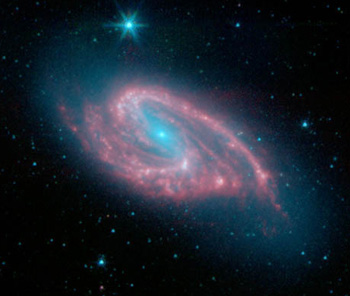Great beauty in art, it is sometimes thought, comes at the price of great strife. Massive forces, both internal and external, shape the flow of artistry. This metaphor applies equally well to galaxies as it does to humans.
Of course, when the Universe is your canvas, the scale’s a little bigger. Like with this dramatic Hubble view of the spiral galaxy M66:
[Oh yes, you most assuredly want to click that to see the galactic 3906 x 2702 pixel version.]
Mmmmm, pretty. Artistically, I like this shot in particular because of the angle and the way it’s framed; when I look at it I get the impression that it’s looming over me, and I perceive it to be sliding by. The sense of motion frozen in time is palpable.
But then the nerdy science part of my brain kicks in; numbers and physics fill in the back story of the artistry, making the picture even cooler than it looks. That galaxy is as big as the Milky Way: 100,000 light years across. It’s 35 million light years away – 350 quintillion kilometers, more than 200 quintillion miles. It’s also part of a trio of galaxies, the other two being M65 and NGC 3628 – the Leo Triplet. When I was younger, I used to observe them through my telescope in late spring when Leo the Lion was high in the sky to the southwest. They weren’t much more than smudges, but my already-getting-ready-to-be-a-scientist brain knew that I was seeing trillions of stars, dimmed by their unfathomable distance. Those three galaxies are close enough together that the gravity of each affects the other two. See how the spiral arm at the bottom appears to be wider, messier, less organized than the one near the top of the picture? That’s no illusion. It’s thought that a recent pass by NGC 3628 may have bonked M66 pretty hard, disturbing it and messing around with its structure. The core of the galaxy – usually a smooth and symmetric blob – is all weird and misshapen. The pink glow in the image (emitted by hydrogen gas) is where stars are being born, and the deeper red is where they’re being cranked out en masse. Many times, when a galaxy passes near another one, the gas clouds get all riled up, collapsing to form lots of new stars.
 That’s more obvious in the Spitzer Space Telescope image I’ve included here. Spitzer sees far-infrared light, which is emitted by warm gas and dust. You can see how wide and weird the lower spiral arm of M66 is, as if it’s been tugged and pulled, like a piece of taffy.
That’s more obvious in the Spitzer Space Telescope image I’ve included here. Spitzer sees far-infrared light, which is emitted by warm gas and dust. You can see how wide and weird the lower spiral arm of M66 is, as if it’s been tugged and pulled, like a piece of taffy.
In this Spitzer image, gas and dust emission is also colored red, and starlight is blue (seen as a fuzzy glow since individual stars are not visible). You can see the stars are not distributed evenly: instead there’s more to the right; a good sign that another galaxy is affecting M66. Also, since red is gas and dust, that’s where stars are being actively born, and there’s a lot of that going on just outside the central region of the galaxy. That’s yet another sign that this galaxy was disturbed; the gravity of a passing galaxy can push the gas toward the center where it circles the core and forms stars.
And the clincher? In most galaxies, you see one star exploding at the end of its life every century or so. In the past 20 years, M66 has had three! Hot, massive stars don’t live long, only a few million years. So if a galaxy is making more stars than usual, you’ll see more supernovae than usual. Clearly, M66 has been pretty busy lately!
Maybe that’s why I love spiral galaxy pictures so much. They appeal to the parts of my brain evolved to appreciate artistry… and then the sciencey nodes kick in, adding a depth and dimension to the beauty. And art is always better when there’s a good story behind it.
Image credit: NASA, ESA and the Hubble Heritage (STScI/AURA)-ESA/Hubble Collaboration. Acknowledgment: Davide De Martin and Robert Gendler